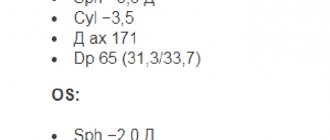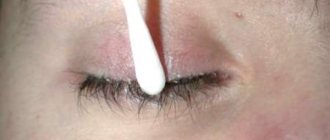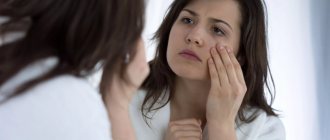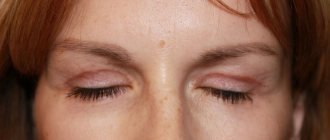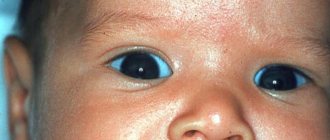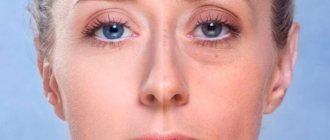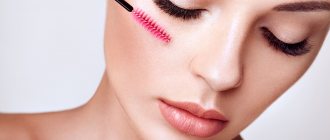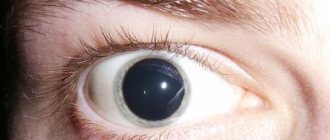Timing and features
The rehabilitation period after blepharoplasty is characterized by the following phenomena:
- swelling in the periorbital area;
- small hematomas;
- tearfulness;
- hypersensitivity of the skin;
- bruising;
- blurred vision;
- blush
In most cases, these symptoms go away after a few days, and pain and discomfort are considered acceptable for the first 10 days.
Blepharoplasty: how long does it take for the suture to heal?
The sutures are removed already on the 4th day after blepharoplasty (they can be left for another 2-3 days), but they take a long time to heal. It takes time for the scar to form and for its further resorption, and this may take 4 weeks.
Healing proceeds much faster if physiotherapy and specific medications are used.
Nuances of recovery by type of operation
Transconjunctival blepharoplasty
Sutures are placed on the mucous side of the eyelid using a laser beam, so they are not visible during examination, and the rehabilitation period is short.
The incisions themselves are more like a puncture through which a specialist carries out lymphatic drainage.
In most cases, surgeons use self-absorbing sutures, which means that a repeat visit to the clinic is not required. On average, all symptoms go away after 5 days.
Lower eyelid blepharoplasty
Recovery times are also relatively low - from 5 days to a week.
This is due to the subtleties of the operation. To speed up the healing process of the skin, a specialist prescribes medicinal compresses and massage.
Upper eyelid blepharoplasty
When correcting the upper eyelids, the recovery process takes a longer time: on average, 9-14 days.
Non-surgical blepharoplasty
There are 2 types - laser and injection.
Both measures imply a minimum rehabilitation period. Symptoms disappear after 2-3 days.
- During the laser procedure, the thinnest and most shallow incision is made in the corrected area, i.e. no skin injury occurs.
- With injection blepharoplasty, no surgical intervention is required at all; after the procedure, there is slight swelling and redness, but everything goes away very quickly.
Outline of the incisions and where the sutures are located after surgery
They form in different places, depending on the type of surgical intervention. In traditional lower eyelid surgery, the outline of the incisions is made slightly below the ciliary edge; in upper blepharoplasty, the contour of the incisions is made at the site where the skin tissue attaches to the levator palpebral muscle.
If the cosmetic procedure is circular, then the incisions are made simultaneously on the lower and upper eyelids. Incisions are made in as inconspicuous places as possible. There will also be two seams. They are performed with intradermal stitches.
The outline of the incisions is made along the natural folds of the skin. The sutures after surgery are placed intradermally. Cosmetic stitches heal and leave a thin scar, which becomes invisible by the end of the 3-month rehabilitation period.
There are no scars with the transconjunctival procedure. This operation is performed through an internal incision in the conjunctiva, so the consequences of the procedure are invisible.
During laser treatment, incisions are not made on the upper and lower eyelids. Areas requiring correction are targeted to a laser beam. The treated areas heal quickly and new tissue appears. The cells continue to renew for a month, but a positive result becomes noticeable after 7 days.
We recommend reading: How to relieve swelling after blepharoplasty
Blepharoplasty of the eyelids called “sangapuri” involves the removal of the epicanthus in the inner corner of the eye. Excess fat tissue is removed. A similar procedure is performed on Asian women. There are sutures, they are created along the muscle aponeuroses. As a result, it is not visible, creating the appearance of a double fold.
Rehabilitation after blepharoplasty by day
The relative period required for the restoration of the epidermis after blepharoplasty lasts 1-2 months. Taking into account some features, the healing process can be divided into several stages.
1 day
At this stage, the patient is released home from the hospital accompanied by a close relative.
To minimize symptoms, you are allowed to take painkillers (for example, Analgin). You should consult a specialist about this in advance.
Additionally, cool compresses are applied - this helps reduce swelling in the eye area and stimulate blood circulation for faster regeneration of connective tissue.
2-3 day
During this period, it is recommended to do eye exercises; the surgeon will tell you about its intricacies during discharge from the hospital.
It is prohibited to watch TV, read, work at a computer or use the phone for a long time.
You can take a mild shower and wash your face, but you should not rub the eye area excessively, and also avoid getting shampoo or other foaming products into the area. It is possible to use Visin drops as prescribed by the surgeon.
Physical contact with the corrected area should be kept to a minimum.
4-5 day
At this stage, the sutures are removed.
Symptoms of diplopia disappear. In case of double vision for a longer period, a visit to the doctor should be made to resolve the situation).
Allowed to read in small quantities.
Day 6
It is allowed to remove antiseptic stickers or patches. There is residual swelling.
Day 7
Complete disappearance of hematomas. The operated patient returns to his usual lifestyle in the absence of pain and the correct healing of the scar.
At this stage, it is not yet allowed to exercise or use cosmetics.
10 day
The bruising goes away completely. You can use cosmetics, but preference should be given to products with exclusively natural ingredients.
Day 14
The boundaries of the seams become almost invisible.
40-45 day
End of the rehabilitation period. All symptoms go away. You can return to your normal lifestyle.
How to speed up the recovery process
During the rehabilitation period, it is necessary to take into account a number of rules and adhere to certain recommendations in order not only to avoid complications, but also to speed up the recovery process.
In the postoperative period, it is important to adhere to a healthy lifestyle and follow a daily routine, as well as perform a number of useful exercises, paying attention not only to the skin, but also to the eye itself.
Physiotherapy
Possible deterioration of the operated area can be prevented through physiotherapy. Thanks to the effects of microcurrents, blood circulation is normalized, and as a result, hematomas, bruises and swelling disappear.
For maximum effect, it is recommended to complete a full course of physiotherapy for 2 months.
Gymnastics
Simple exercises can be done at home (5-6 approaches for each).
They are aimed at recovery after blepharoplasty: they help moisturize the skin, normalize blood circulation and improve muscle tone.
During discharge, the surgeon gives detailed recommendations on the procedures.
- Eye movement according to the “crossroads” principle. First they look straight, and then they move their gaze in different directions, moving slowly, in a circle. After the first approach, you need to rest a little.
- Blink continuously for 40 seconds with your chin up.
- Close your eyelids tightly, close them, without pressing, with the palms of your hands, after rubbing them together (you should feel warm when touching).
- Place your fingers on your eyes, without pressing, and try to open your eyelids.
- Fixation of gaze and rotation of the head without moving away from the selected point.
Eye massage
After blepharoplasty, connective tissue appears over time at the site of the surgical incision, which gradually fills with blood vessels.
For a quick recovery, it is necessary to ensure their blood supply. A therapeutic massage is suitable for this purpose (during this, it is strictly forbidden to stretch the dermis).
- Clockwise with two fingers, make light movements around the eyes, then on the border of the lower eyelid, make a series of light point pressure in the direction from the outer to the inner corner.
- Repeat the same steps towards the center. Make smooth movements in the area under the eyebrow.
Skin care
The use of cosmetics is strictly contraindicated.
Habitual moisturizing creams and cosmetics should be excluded for some period. You should wash and shower with extreme caution, using only mild soap with a neutral level of acidity and alkali.
During water procedures, try to prevent moisture from getting on the healing scars.
Buyanov Sergey Yurievich (Expert Doctor):
After washing, you should not wipe your face with a towel. It is recommended to pin it to your face. This way you can avoid stretching and displacement of the skin.
Microcurrents
The procedure is carried out to prevent the formation of keloid scars after surgery, as well as to speed up the healing process.
During the course of microcurrent therapy the following is observed:
- acceleration of wound healing;
- restoration and relaxation of muscle tissue;
- normalization of lymph outflow;
- reducing swelling by removing excess fluid from connective tissue;
- minimizing inflammation and fatigue.
Laser resurfacing
The effectiveness of the event lies in the effect of a carbon dioxide laser on the skin, which helps cleanse the upper keratinized layers of the dermis.
The procedure is prescribed after 2 months from the date of blepharoplasty. Promotes renewal of epidermal cells, eliminates scars and normalizes metabolic processes.
Mesotherapy
It involves cell regeneration and acceleration of recovery processes through injections of specialized preparations containing hyaluronic acid and amino acids. With the help of a mesotherapy cosmetology session, the hydrobalance in the skin cells is restored and the general condition of the dermis is improved.
Buyanov Sergey Yurievich (Expert Doctor):
Mesotherapy procedures help restore skin by increasing metabolism in the area of surgery. Hyaluronic acid fills the spaces of suspected intradermal scars, amino acids are embedded in collagen and elastic fibers, preventing the formation of connective tissue.
Medicines and cosmetics
If rehabilitation proceeds correctly, the doctor, in most cases, does not prescribe medications, but the surgeon may recommend the use of certain means to speed up the healing process.
These may include ointments, eye drops and medicinal compresses.
Ointments
- Lokoid . Helps relieve swelling and inflammation, providing a disinfectant effect.
- Lyoton . Helps eliminate bruises, swelling and inflammation. Has an analgesic effect.
- Dermatix . Eliminates pigmentation, softens scars and strengthens capillaries.
- Troxevasin . Helps manage mild swelling and bruising in the corrected area.
- Contractubex . Helps smooth out the relief during scar formation.
Drops
It is recommended to use eye drops for the first few days to prevent the conjunctiva from drying out and causing infection. The drug should be instilled every 3-4 hours.
Among the common ones are Albucid and Levomycetin.
Buyanov Sergey Yurievich (Expert Doctor):
To moisturize the conjunctiva, you can also use drops of natural or artificial tears, “Defislez”. The products moisturize the conjunctiva without providing additional pharmacological load.
Therapeutic compresses
Decoctions of chamomile, calendula or rosemary have a beneficial effect on the skin. Raw materials for infusions are freely available at any pharmacy.
To prepare, you need to infuse 1 tablespoon of dried herb in 0.5 liters of hot water, cool, and then apply it as a compress. The remains can also be used for medicinal purposes.
What is prohibited
During the recovery stage after surgery, it is necessary to adhere to a number of restrictions in order to avoid deterioration in health.
- It is not recommended to sleep on a low pillow. Positioning the head at a large angle ensures proper drainage of lymph.
- Stick to proper nutrition or a light diet. Eliminate foods high in salt from your diet, as they contribute to stagnation of moisture in the body, resulting in swelling that takes a long time to resolve.
- Alcohol, soda and cigarettes are taboo.
- Provide a state of comfort and tranquility for the eyes. Minimize watching TV, sitting at the computer, and reading printed materials.
- You should protect your eyes from temperature changes and exposure to ultraviolet radiation, so it is contraindicated to visit a sauna, solarium, take hot baths, or stay outside for a long time during frost. During the summer months, it is recommended to wear sunglasses that block direct sunlight.
- Coffee lovers will have to refrain from drinking this drink. Instead, drink as much clean water as possible.
- It is necessary to wash your hair and wash your face carefully for the first few days - water should not get into your eyes or on your seams.
- It is also prohibited to play sports, as well as any physical activity that can provoke an increase in intraocular pressure.
- The use of cosmetics and “aggressive” cleansers is prohibited. It is recommended to choose a towel with a delicate and soft texture.
Eye exercises
To keep the circular muscles in the eyelid area in good shape, plastic surgeons advise doing the following exercises:
- Warm-up consists of simple movements of the eyeballs. First you need to look forward, then move your eyes to the left and fixate for a couple of seconds, then to the right. Then look up and lower your pupils;
- lift your head up and find some detail on the ceiling. Now, without changing your position, start blinking actively for 30 seconds;
- close your eyes, after a couple of seconds open them and look ahead. Then squeeze your eyelids tightly, trying to do this so that the brow ridges do not move. Repeat this exercise 5 times;
- as in the previous version, this gymnastics prohibits moving the eyebrows during the exercises. Close your eyes and place the pads of your index fingers on your upper eyelid - they should be strictly in the middle or parallel to the bridge of your nose. Now, overcoming resistance, try to open your eyes. The procedure is repeated a couple of times;
- tilt your head back and concentrate on the tip of your nose. Sit down, but immediately move your gaze forward;
- do the exercises Chinese. Place your fingertips at the outer edge of your eyes (eyelids should be closed). Swipe them to the side, moving as if towards your temples. Sit down again and repeat the action up to 5 times.
We recommend: What care is needed after upper eyelid blepharoplasty?
If you do all of these exercises during the first two weeks after surgery, you will see bruising, swelling, and scarring disappear quickly.
Possible complications and side effects
Blepharoplasty, like any surgical procedure, has a number of possible side effects.
This may be due to the individual characteristics of the patient, a doctor’s mistake or non-compliance with the rules of the rehabilitation period.
Keloid scars
Effective methods to solve the problem are steroid injections and laser resurfacing.
It is also possible to use targeted ointments and exposure to liquid nitrogen at low temperatures (cryotherapy). Symptoms characteristic of scar formation:
- growths;
- itching, burning;
- pain;
- expansion of the scar area.
Seals
Subcutaneous lumps (bumps) occur due to:
- swelling;
- cysts due to improper formation of the suture;
- incorrect connection of the cartilage located along the contour of the eyelashes and the muscle of the eyelid;
- pyogenic granulomas.
Keratoconjunctivitis
A common occurrence after the procedure is due to drying out of the mucous membrane of the eye.
For prevention, eye drops are used to maintain the required level of conjunctival moisture.
Folds
The appearance of irregular relief in the periorbital zone is associated with excessive removal of the fat layer during surgery. The situation can only be corrected by repeated surgery.
Also, during the surgeon’s incorrect work, problems such as:
- diplopia (with damage to the eye muscles);
- blepharoptosis (downward displacement of the upper eyelid);
- hematoma (due to damage to blood vessels);
- eversion of the eye;
- hematoma of the inner side of the eyeball.
Seam divergence, asymmetry
They are the result of improper suturing during surgery. Also, wound dehiscence is associated with poor-quality surgical material.
